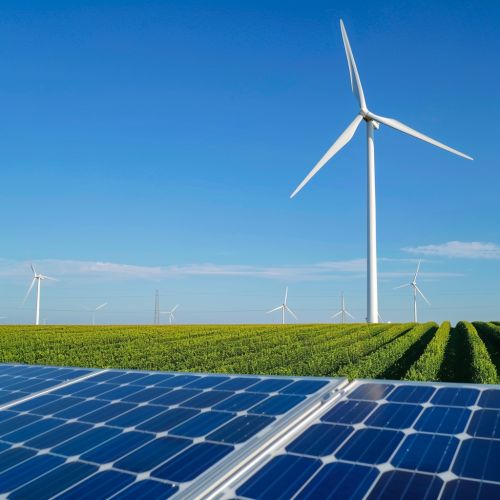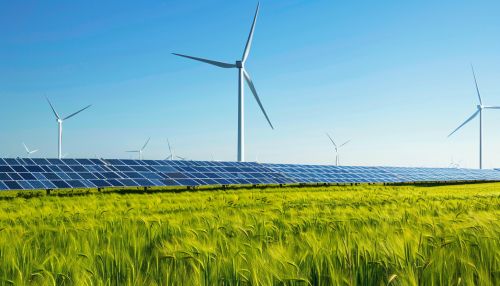Climate change and energy security: Difference between revisions
(Created page with "== Introduction == Climate change and energy security are two interlinked global challenges that have significant implications for the environment, economy, and society. Climate change refers to long-term alterations in temperature, precipitation, and other atmospheric conditions, primarily driven by human activities such as the burning of fossil fuels, deforestation, and industrial processes. Energy security, on the other hand, pertains to the reliable and adequate sup...") |
No edit summary |
||
| Line 121: | Line 121: | ||
The nexus between climate change and energy security presents both challenges and opportunities. While efforts to mitigate climate change can enhance energy security by reducing dependence on fossil fuels, they also require substantial investments and technological advancements. Addressing these interconnected issues necessitates a comprehensive approach that includes policy and regulatory frameworks, technological innovations, and societal engagement. By working together, governments, businesses, and individuals can create a sustainable and secure energy future. | The nexus between climate change and energy security presents both challenges and opportunities. While efforts to mitigate climate change can enhance energy security by reducing dependence on fossil fuels, they also require substantial investments and technological advancements. Addressing these interconnected issues necessitates a comprehensive approach that includes policy and regulatory frameworks, technological innovations, and societal engagement. By working together, governments, businesses, and individuals can create a sustainable and secure energy future. | ||
[[Image:Detail-93317.jpg|thumb|center|Wind turbines and solar panels in a green field under a clear blue sky.|class=only_on_mobile]] | |||
[[Image:Detail-93318.jpg|thumb|center|Wind turbines and solar panels in a green field under a clear blue sky.|class=only_on_desktop]] | |||
== See Also == | == See Also == | ||
Latest revision as of 09:19, 22 June 2024
Introduction
Climate change and energy security are two interlinked global challenges that have significant implications for the environment, economy, and society. Climate change refers to long-term alterations in temperature, precipitation, and other atmospheric conditions, primarily driven by human activities such as the burning of fossil fuels, deforestation, and industrial processes. Energy security, on the other hand, pertains to the reliable and adequate supply of energy at affordable prices. The nexus between climate change and energy security is complex, as efforts to mitigate climate change often impact energy security and vice versa.
Climate Change: Causes and Impacts
Climate change is driven by the accumulation of greenhouse gases (GHGs) in the atmosphere, which trap heat and lead to global warming. The primary sources of GHGs include carbon dioxide (CO2) from fossil fuel combustion, methane (CH4) from agriculture and waste management, and nitrous oxide (N2O) from industrial activities.
Environmental Impacts
The environmental impacts of climate change are profound and widespread. These include:
- **Rising Temperatures:** Global temperatures have increased by approximately 1.2°C since the pre-industrial era, leading to more frequent and severe heatwaves.
- **Melting Ice Caps and Glaciers:** The polar ice caps and glaciers are melting at an unprecedented rate, contributing to rising sea levels.
- **Ocean Acidification:** Increased CO2 levels are causing the oceans to become more acidic, affecting marine life and ecosystems.
- **Extreme Weather Events:** There is an increase in the frequency and intensity of extreme weather events such as hurricanes, droughts, and floods.
Socio-Economic Impacts
Climate change also has significant socio-economic impacts, including:
- **Agricultural Productivity:** Changes in temperature and precipitation patterns can affect crop yields, leading to food insecurity.
- **Health Risks:** Increased temperatures and extreme weather events can exacerbate health issues, including heat-related illnesses and the spread of vector-borne diseases.
- **Economic Costs:** The economic costs of climate change are substantial, including damage to infrastructure, loss of productivity, and increased healthcare expenses.
Energy Security: Definition and Challenges
Energy security is defined as the uninterrupted availability of energy sources at an affordable price. It encompasses various dimensions, including the reliability of supply, the diversity of energy sources, and the resilience of energy infrastructure.
Key Challenges
The key challenges to energy security include:
- **Dependence on Fossil Fuels:** Many countries rely heavily on fossil fuels such as oil, coal, and natural gas, which are finite resources and subject to geopolitical tensions.
- **Supply Disruptions:** Natural disasters, political instability, and conflicts can disrupt energy supplies, leading to shortages and price volatility.
- **Infrastructure Vulnerabilities:** Aging energy infrastructure and the risk of cyber-attacks pose significant threats to energy security.
The Nexus Between Climate Change and Energy Security
The relationship between climate change and energy security is multifaceted. Efforts to mitigate climate change, such as transitioning to renewable energy sources, can enhance energy security by reducing dependence on fossil fuels. However, this transition also presents challenges, including the need for substantial investments in new infrastructure and the intermittency of renewable energy sources.
Renewable Energy and Energy Security
Renewable energy sources, such as solar, wind, and hydropower, offer significant potential for reducing GHG emissions and enhancing energy security. These sources are abundant, widely distributed, and have low operational costs once established.
- **Solar Energy:** Solar power harnesses energy from the sun using photovoltaic cells or solar thermal systems. It is a clean and renewable source of energy that can be deployed at various scales, from small rooftop installations to large solar farms.
- **Wind Energy:** Wind power generates electricity by converting the kinetic energy of wind into mechanical energy using wind turbines. It is one of the fastest-growing renewable energy sources.
- **Hydropower:** Hydropower utilizes the energy of flowing water to generate electricity. It is a reliable and flexible source of renewable energy, particularly in regions with abundant water resources.
Challenges of Renewable Energy Integration
Despite their benefits, integrating renewable energy sources into the existing energy system presents several challenges:
- **Intermittency:** Renewable energy sources such as solar and wind are intermittent, meaning their output can vary depending on weather conditions. This requires the development of energy storage solutions and grid management strategies to ensure a stable supply.
- **Infrastructure Investments:** Transitioning to renewable energy requires significant investments in new infrastructure, including transmission lines, storage facilities, and smart grids.
- **Resource Availability:** The availability of renewable energy resources varies by region, necessitating a diversified energy mix to ensure reliability.
Policy and Regulatory Frameworks
Effective policy and regulatory frameworks are essential for addressing the dual challenges of climate change and energy security. These frameworks can incentivize the adoption of clean energy technologies, promote energy efficiency, and support research and development.
International Agreements
Several international agreements and initiatives aim to address climate change and promote energy security:
- **Paris Agreement:** The Paris Agreement is a landmark international treaty that aims to limit global warming to well below 2°C above pre-industrial levels. It encourages countries to adopt nationally determined contributions (NDCs) to reduce GHG emissions.
- **United Nations Framework Convention on Climate Change (UNFCCC):** The UNFCCC is an international environmental treaty that provides a framework for negotiating specific agreements to combat climate change.
National Policies
Countries have implemented various national policies to enhance energy security and mitigate climate change:
- **Renewable Energy Targets:** Many countries have set ambitious targets for increasing the share of renewable energy in their energy mix.
- **Energy Efficiency Standards:** Governments have established energy efficiency standards for buildings, appliances, and vehicles to reduce energy consumption and GHG emissions.
- **Carbon Pricing:** Carbon pricing mechanisms, such as carbon taxes and cap-and-trade systems, aim to internalize the environmental costs of GHG emissions and incentivize low-carbon technologies.
Technological Innovations
Technological innovations play a crucial role in addressing climate change and enhancing energy security. Advances in clean energy technologies, energy storage, and smart grid systems are transforming the energy landscape.
Clean Energy Technologies
- **Advanced Photovoltaics:** Innovations in photovoltaic technology are improving the efficiency and affordability of solar panels.
- **Offshore Wind:** Offshore wind farms have the potential to generate significant amounts of electricity, particularly in regions with strong and consistent winds.
- **Next-Generation Nuclear:** Advanced nuclear reactors, including small modular reactors (SMRs), offer a low-carbon and reliable source of energy.
Energy Storage
Energy storage technologies are essential for managing the intermittency of renewable energy sources and ensuring a stable energy supply:
- **Battery Storage:** Lithium-ion batteries are widely used for energy storage due to their high energy density and efficiency. Research is ongoing to develop next-generation batteries with improved performance and lower costs.
- **Pumped Hydro Storage:** Pumped hydro storage uses excess electricity to pump water to a higher elevation, which can then be released to generate electricity when needed.
Smart Grids
Smart grids use digital technology to enhance the efficiency, reliability, and resilience of the electricity grid:
- **Demand Response:** Smart grids enable demand response programs, which adjust electricity consumption in response to supply conditions, helping to balance the grid.
- **Grid Modernization:** Upgrading the grid with advanced sensors, communication networks, and automation systems improves its ability to integrate renewable energy sources and respond to disruptions.
Societal and Behavioral Aspects
Addressing climate change and energy security also requires changes in societal behavior and public awareness. Public engagement and education are critical for fostering support for clean energy initiatives and sustainable practices.
Public Awareness and Education
Raising public awareness about the impacts of climate change and the importance of energy security can drive behavioral changes and support for policy measures:
- **Educational Campaigns:** Governments and organizations can conduct educational campaigns to inform the public about energy conservation, renewable energy, and climate change mitigation.
- **Community Programs:** Community-based programs can promote energy efficiency and renewable energy adoption at the local level.
Behavioral Changes
Individual and collective behavioral changes can significantly contribute to reducing GHG emissions and enhancing energy security:
- **Energy Conservation:** Simple actions such as reducing energy consumption, using energy-efficient appliances, and adopting sustainable transportation options can make a substantial difference.
- **Support for Clean Energy:** Public support for clean energy policies and investments can accelerate the transition to a low-carbon energy system.
Conclusion
The nexus between climate change and energy security presents both challenges and opportunities. While efforts to mitigate climate change can enhance energy security by reducing dependence on fossil fuels, they also require substantial investments and technological advancements. Addressing these interconnected issues necessitates a comprehensive approach that includes policy and regulatory frameworks, technological innovations, and societal engagement. By working together, governments, businesses, and individuals can create a sustainable and secure energy future.


